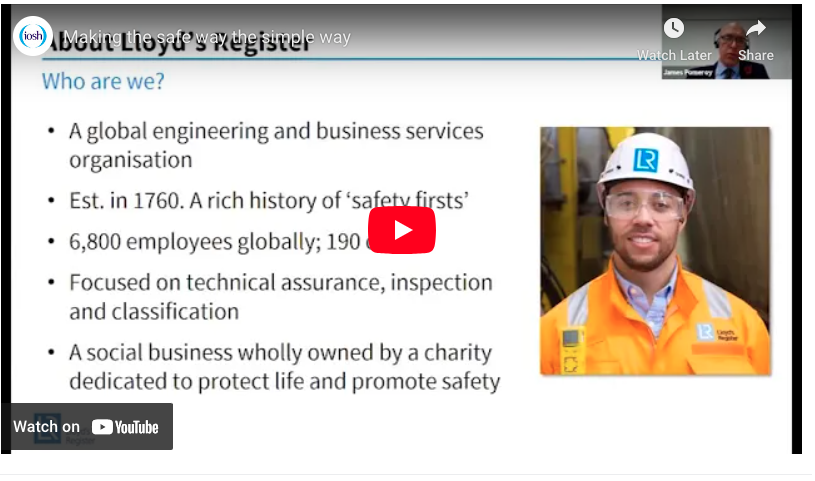Simplifying Safety
Making the safe way the simple way
What is the best way to improve environmental health and safety in your organization? According to James Pomeroy—Group Director of Health, Safety, Environment and Safety at Lloyd’s Register—the solution may lie in simplification.
In an interesting IOSH Swiss Network webinar, James discussed his thoughts with Alison Hinde (CEO Proactively, Chair IOSH Swiss Network). James noted that the mechanization of processes and procedures tends to defeat the core underpinnings of safety in an organization. Drawing on over 2 decades of experience, he is of the opinion that “The complexity of how we’ve made safety is creating a disconnection with employees.” Unnecessary complications merely increase the risk of misoperation and error.
A good example provided by James is the idea of handing out a 560-page safety management system as compared to a simplified 50-page alternative. With the former, it’s difficult for anyone to understand what he/she is supposed to do when overwhelmed by such a large volume of safety procedures and measures.
Read on—or watch the IOSH Swiss Network’s YouTube video on “Making the Safe Way the Simple Way”—for more on why simplification is important and how to transform global health environmental programs.
“Life is really simple, but we insist on making it complicated.” Confucius
The State of Environmental Health and Safety
Global and EU organizations have developed deep expertise in safety—whereby there’s a good understanding of risk, increased recognition of health (i.e., scope), the professionalization of safety, and increased standardization of processes/systems.
But the key question is; are these measures having the desired effect? Despite these commendable developments in terms of environmental health and safety, injury, illness, and death statistics are still a source of concern. According to figures provided by James Pomeroy:
- The UK records approximately 70,000 serious injuries every year—and the reductions have plateaued over the years.
- 3 million workers in the UK are affected by poor health annually.
- Around 142 deaths are reported in the UK every year.
The first step towards transforming global health environmental programs is understanding the new world of work.</p>
-
The Virtual worker: This includes part-time work and the gig-related work. This introduction of different forms of employment is relevant for environmental health and safety because it questions the contract with employees and how far organizations can go in terms of providing the right equipment.
-
Data and Digital: Understanding data improves the opportunities for targeted interventions. James reiterates the importance of being careful with data—in line with the regulations of the GDPR (General Data Protection Regulation).
-
Gen Z: The employees that are coming through our workplaces think differently; want to be engaged differently; demand different forms of employment.
-
Ageing Workforce: Drawing from examples at Lloyd’s and other organizations he has interacted with, James points to an ageing workforce—with people working into their late 60s and 70s.
-
Mental Health: There’s been a considerable focus on mental health as part of environmental health and safety in addition to physical wellbeing.
What is the Way Forward?
Drawing on the new world of work and the disconnection due to mechanization of safety, Lloyd’s Register and James developed an HSES plan to promote impactful change as shown below:
Focus on What Really Matters – Sweat the Big Stuff
The simplification strategy adopted by James and Lloyd’s Register starts with cutting down on the processes to focus on key risks. The idea is based on the law of diminishing returns—whereby the more safety measures and processes you prescribe to your employees, the less they remember.
“looking at the data, doing some studies, applying concepts such as Pareto’s and Miller’s Law, and using that to form the basis of our training. We’re not trying to capture everything; we’re just trying to capture the things that are most important and have the biggest impact.” James Pomeroy
Engage – Making Emotional Connections
Involve your employees in the development of the safety processes through consultations, workshops, and data. By driving engagement and discussing potential barriers, you get to improving competency in the workplace.
Simplification, James notes, is best achieved by giving employees who are closest to the task the opportunity to make informed decisions – i.e. best approaches for assessing and controlling risks.
It’s also important to make environmental health and safety personal by promoting horizontal learning (i.e., peer-to-peer learning) and creating a culture of storytelling. Hearing a colleague narrate their experience with a safety risk in a hazardous environment is more memorable and impactful than reading off a safety alert.
Innovate – Key to Performance Improvements
Safety is undergoing a transformation in the digital age—from dynamic PPE that give body information, data & analytics, to smart wearables. As an organization, it’s important to embrace and leverage these technological developments by providing tools such as apps to make the processes easier, creating rich data sets, and using databases to store, retrieve, and track completed tasks.

